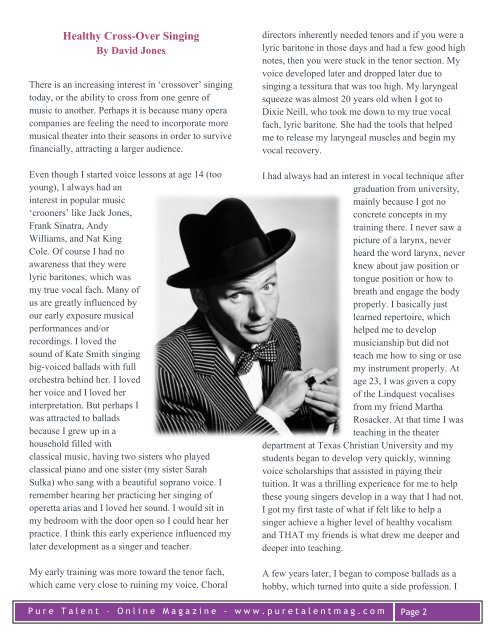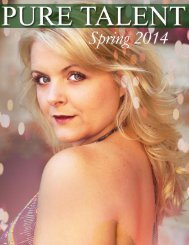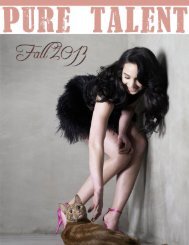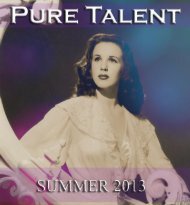Classical Crossover Magazine, Winter 2013
Create successful ePaper yourself
Turn your PDF publications into a flip-book with our unique Google optimized e-Paper software.
Healthy Cross-Over Singing<br />
By David Jones<br />
There is an increasing interest in ‘crossover’ singing<br />
today, or the ability to cross from one genre of<br />
music to another. Perhaps it is because many opera<br />
companies are feeling the need to incorporate more<br />
musical theater into their seasons in order to survive<br />
financially, attracting a larger audience.<br />
Even though I started voice lessons at age 14 (too<br />
young), I always had an<br />
interest in popular music<br />
‘crooners’ like Jack Jones,<br />
Frank Sinatra, Andy<br />
Williams, and Nat King<br />
Cole. Of course I had no<br />
awareness that they were<br />
lyric baritones, which was<br />
my true vocal fach. Many of<br />
us are greatly influenced by<br />
our early exposure musical<br />
performances and/or<br />
recordings. I loved the<br />
sound of Kate Smith singing<br />
big-voiced ballads with full<br />
orchestra behind her. I loved<br />
her voice and I loved her<br />
interpretation. But perhaps I<br />
was attracted to ballads<br />
because I grew up in a<br />
household filled with<br />
classical music, having two sisters who played<br />
classical piano and one sister (my sister Sarah<br />
Sulka) who sang with a beautiful soprano voice. I<br />
remember hearing her practicing her singing of<br />
operetta arias and I loved her sound. I would sit in<br />
my bedroom with the door open so I could hear her<br />
practice. I think this early experience influenced my<br />
later development as a singer and teacher.<br />
My early training was more toward the tenor fach,<br />
which came very close to ruining my voice. Choral<br />
directors inherently needed tenors and if you were a<br />
lyric baritone in those days and had a few good high<br />
notes, then you were stuck in the tenor section. My<br />
voice developed later and dropped later due to<br />
singing a tessitura that was too high. My laryngeal<br />
squeeze was almost 20 years old when I got to<br />
Dixie Neill, who took me down to my true vocal<br />
fach, lyric baritone. She had the tools that helped<br />
me to release my laryngeal muscles and begin my<br />
vocal recovery.<br />
I had always had an interest in vocal technique after<br />
graduation from university,<br />
mainly because I got no<br />
concrete concepts in my<br />
training there. I never saw a<br />
picture of a larynx, never<br />
heard the word larynx, never<br />
knew about jaw position or<br />
tongue position or how to<br />
breath and engage the body<br />
properly. I basically just<br />
learned repertoire, which<br />
helped me to develop<br />
musicianship but did not<br />
teach me how to sing or use<br />
my instrument properly. At<br />
age 23, I was given a copy<br />
of the Lindquest vocalises<br />
from my friend Martha<br />
Rosacker. At that time I was<br />
teaching in the theater<br />
department at Texas Christian University and my<br />
students began to develop very quickly, winning<br />
voice scholarships that assisted in paying their<br />
tuition. It was a thrilling experience for me to help<br />
these young singers develop in a way that I had not.<br />
I got my first taste of what if felt like to help a<br />
singer achieve a higher level of healthy vocalism<br />
and THAT my friends is what drew me deeper and<br />
deeper into teaching.<br />
A few years later, I began to compose ballads as a<br />
hobby, which turned into quite a side profession. I<br />
P u r e T a l e n t – O n l i n e M a g a z i n e - w w w . p u r e t a l e n t m a g . c o m Page 2







